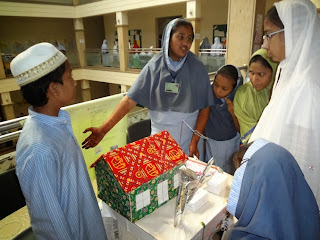This blog is for teachers, principals and other stakeholders who are part of the Attalim Schools' Professional Learning Community. This is a space for sharing success stories, student work, readings, reflections, questions and ideas. We hope this blog will encourage on-going dialogue, collaborative learning and professional growth, even as we focus our efforts on improving student learning.
This site is maintained by Reniscience Education LLP. <--- Click on the link to visit our page and support us!
Tuesday, 29 October 2013
Monday, 28 October 2013
Input Rich Classrooms
As we had discussed, Input-Rich language classrooms have both fiction and nonfiction resources. Here is a table that explains the elements of both types of resources to teach English!!
Fiction
|
Non-Fiction
|
Both Categories
|
It is invented or imagined
by the author
|
It tells about real people,
places, events, thoughts, and times.
|
Table of contents
|
The author’s job of writing
is only half the process. You bring a story to life by using your imagination.
|
You
are informed of what is happening or has happened in the world.
|
Reading in order will help comprehend better
|
Plays, novels, short
stories, fables, fairytales, fantasy, Science Fiction, poetry
|
Autobiographies,
biographies, newspaper and magazine articles, Editorials and letters to the
editor, Diaries and journals, speech, reports
|
|
It is easier to remember
|
It requires you to be more
critical in your reading as compared to other texts
|
Topic could be about almost anything
|
You read it quicker
|
It
is mostly read for a particular purpose.
|
You need to have a
beginning, middle, and end to the story
|
Usually read for pleasure
|
Details are important. You
look at more than “the big picture”.
|
You come across new
vocabulary
|
Details are not as important
as big picture
|
It
is often hard to form mental images
|
Have a main idea
|
Use
your imagination to form mental images
|
It
is about facts
|
|
Has
at least one character
|
Often
there are charts, tables, and graphs to help you understand what you’re
reading.
|
|
Characters
may or may not be real/ human
|
May
or may not have characters
|
|
Any
character is or was alive
|
How to become a master of "classroom management"
1. Thumbs-up, thumbs-down, thumbs-to the side: This is used for as a QUICK check for understanding of instructions or as an INFORMAL assessment for whether kids need more clarity on some content.
2. Eye contact with every child
3. Walk around the room
4. When teacher raises her hand, students should stop whatever they are doing, stop talking, raise their hand and look at the teacher. This is all done in silence. Great for transition from small group work to whole class or when teacher wants to give some instruction
5. Countdowns for transitions,like giving them 20 seconds to make groups, 10 seconds to take out their books, 20 seconds to pass worksheets, etc.
6. Strict time limits on group discussions with CLEAR roles and VERY CLEAR instructions. Teachers should give the FULL TIME that they have mentioned in order to do justice to students but they should also give a time check.
7. Use of structured discussions so that everyone gets a chance to talk and listen and is engaged and on topic
8. Clear instructions, clear instructions, clear instructions
9. Consistent classroom norms that are non punitive
10. Short readings with clear tasks on what students are supposed to do during the reading and then time to debrief the task. For example if you have asked them to circle 2 new words, you HAVE to make time to discuss them else the next time kids won't do it.
11. Closure
12. If homework is assigned, it MUST be discussed the next day!
13. Clear learning outcomes and activities ALIGNED ONLY to that LO.
14. Lots of structures and scaffolds to guide student thinking. Could be graphic organizers, etc.
And the MOST IMPORTANT.....
2. Eye contact with every child
3. Walk around the room
4. When teacher raises her hand, students should stop whatever they are doing, stop talking, raise their hand and look at the teacher. This is all done in silence. Great for transition from small group work to whole class or when teacher wants to give some instruction
5. Countdowns for transitions,like giving them 20 seconds to make groups, 10 seconds to take out their books, 20 seconds to pass worksheets, etc.
6. Strict time limits on group discussions with CLEAR roles and VERY CLEAR instructions. Teachers should give the FULL TIME that they have mentioned in order to do justice to students but they should also give a time check.
7. Use of structured discussions so that everyone gets a chance to talk and listen and is engaged and on topic
8. Clear instructions, clear instructions, clear instructions
9. Consistent classroom norms that are non punitive
10. Short readings with clear tasks on what students are supposed to do during the reading and then time to debrief the task. For example if you have asked them to circle 2 new words, you HAVE to make time to discuss them else the next time kids won't do it.
11. Closure
12. If homework is assigned, it MUST be discussed the next day!
13. Clear learning outcomes and activities ALIGNED ONLY to that LO.
14. Lots of structures and scaffolds to guide student thinking. Could be graphic organizers, etc.
And the MOST IMPORTANT.....
Saturday, 26 October 2013
Subscribe to:
Comments (Atom)




































































